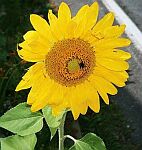 |
|
|
"If I remember the sunflower forest it is because from its hidden reaches man arose. The green world is his sacred center. In moments of sanity he must still seek refuge there." — Loren Eiseley
The scientific word for Sunflower is Hellianthus, derived from helios meaning sun and anthos meaning flower. Its name refers to the ability of the sunflower to follow the sun from sunrise until sunset. This glorious plant, which can reach a height of 12 feet, turns its giant head to gather the sun's rays, making a silent, simple, yet stark and spontaneous statement to all that it is nature and sunlight that provides for us.
On June 4, 1996, the defense ministers of the U.S., Russia, and Ukraine gathered at the Pervomaisk missile base to celebrate Ukraine's transfer of its nuclear warheads to Russia for dismantling. The defense ministers planted sunflowers where missiles were once buried. U.S. Secretary of Defense William Perry stated, "Sunflowers instead of missiles in the soil would ensure peace for future generations."
The Sunflower Project is dedicated to taking the 1996 Ukrainian missile gesture and fostering a worldwide campaign to encourage people everywhere to plant Sunflowers throughout their cities, towns, communities, and countrysides as living symbols of peace and to celebrate our connection to nature.
Sunflowers sprouting tall across our Earth will remind us to trust in nature as our most important resource, and let others know that we, the people on the planet, want clean air, water and food, as well as peace in our homes, schools, and between nations.
The Sunflower Project vision is to see all people in every corner of the globe who are concerned about nuclear war, pollution, violence, injustice, and/or threats to the balance of nature, to plant at least one sunflower seed in a sunny place where it will be noticed. The Project envisions, rather than orderly rows of sunflowers, just one or two plants springing up here and there -- for the 'surprise factor'. However, in the case of an empty city lot, a dozen or so sunflowers throughout the lot would make a greater impression. Or, surrounding a bleak parking lot at a mall in the suburbs there could be several sunflowers, where one alone could get lost, or weeded out.
The sunflower, besides being admired as an extraordinary ornamental, is easy to grow and has an amazing variety of uses. It's seeds provide food for birds, animals, and humans. Sunflower seeds sprouts are a delight, dyes come from the petals, paper can be made from the stalk, and Sunflower seed oil is healthy and useful.
The sunflower has inhabited the earth, for over 8,000 years. There are over 2,000 varieties of Sunflowers identified to date, but the largest, strongest, and most striking Sunflowers are the "Mammoth Russians" which grow 6 to 12 feet. They are also know as "Russian Giants", "Tall Russians", "Russian Grey stripes", or simply "Mammoths". These sunflowers are known, not only for their height, but for their large seed heads. The largest sunflower head, grown in Canada measured 32 - 1/2 inches, and the tallest sunflower, grown in the Netherlands, was 25 feet tall.
According to Traditional Folk Wisdom: "Sleeping with a sunflower under your pillow will permit you to know the truth of any matter," and "It is Bad luck to cut down a sunflower".
(Man) must make, by way of his cultural world, an actual conscious reentry into the sunflower forest he had thought to merely exploit or abandon. He must do this in order to survive. — The Invisible Pyramid ----Loren Eisel
Planting:
If
possible choose a site in full sun. In most areas,
wait till danger of frost is over. Sunflowers are a
long season crop. Germination is 7 to 14 days. and
full growth takes 60 to 90 days. You can plant
directly into the soil. Soak the seeds overnight and
plant them in warm soil about 24 inches apart. Cover
the seeds with a light cover of soil, about a half
inch, and water them. If you plant closer
together you may need to thin them. In this case you
could transplant some of the plants when about 4
inches high to another location. As they are such a
tall plant they need plenty of room. The "Mammoth" or
"Russian" sunflower grows 6 to 12 feet tall. To start
the seeds indoors, you can get peat seed pots from
your local garden shop. You can fill with soil or
starter mix, then plant the seed, and water. You
then plant this whole seed pot once the seedling is 4
inches high or so, making sure it is covered by soil.
Sunflowers are quite drought tolerant, yet need good
watering to get started.
Possible
Problems:
Sunflowers
are remarkably trouble free, though aphids are
sometimes a problem, but can often be controlled by
spraying with water or garlic spray, or by encouraging
native predators such as lady bugs. Of course, birds
will love to eat the seeds. To protect some flowers,
you can cover the seed heads with cheesecloth for a
while.
Remembering
mainly, Sunflowers need lots of sunlight.